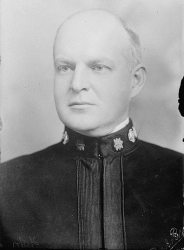
 |
|
|
||
|
Clarence Stewart Williams |
||||
|
Graduate, U.S. Naval Academy, Class of 1884 Engagements: • Spanish-American War (1898)• World War I (1914 - 1918) |
||||
| Biography: | ||||
|
Clarence Stewart Williams Admiral, U.S. Navy Clarence Stewart Williams was born on 7 October 1863 in Springfield, OH, to Orson and Pamela Floyd Williams. He graduated from the U.S. Naval Academy in 1884 and was ordered to the sloop USS Hartford, flagship of the Pacific Squadron. He then served aboard the Coast Survey schooner Eagre from 1886-87; aboard the sloop Ossipee patrolling the Gulf of Saint Lawrence from 1887-89; and as Instructor in Mathematics at the U.S. Naval Academy from 1889-93. From 1893-96, he served as Watch Officer aboard the protected cruiser USS Charleston, which protected American interests and shipping in South America during the Brazilian Revolution and evacuated missionaries from the coast of China during the Sino-Japanese War. He returned to the Academy as an Instructor of Higher Mathematics from 1896-98. During the Spanish-American War, he commanded the newly commissioned gunboat USS Gwin, which participated in the blockade of Cuba as a dispatch vessel. He was Watch Officer aboard the unarmored cruiser USS Marblehead from 1899-1900 and aboard the battleship USS Iowa from 1900-01. He participated in a preliminary hydrographic survey of Midway Island for a cable station in 1901. From 1901-03, he was an Instructor of Navigation at the Academy, then served as Executive Officer of the hospital ship USS Solace; as Executive Officer of the monitor USS Monterey; and as Navigator of the training ship Prairie during 1903-04. He was Executive Officer of Iowa from 1904-05, Navigator of the battleship Massachusetts in 1905, and Executive Officer of Iowa again from 1905-07. He was a member of the Board of Inspection and Survey from 1911 to 1912. He commanded the battleship Rhode Island from 1912-15, including operations during the Mexican Campaign of 1914. During World War I, he served as Chief of Staff of the Battleship Force, Atlantic Fleet; as Commander of Battleship Division 8, Atlantic Fleet; and as Commander of Light Cruiser Division 1, Pacific Fleet, on detached duty in the South Atlantic. He served briefly as Chief of Staff of the Naval War College early in 1919, but was transferred in June to command Battleship Squadron 4, Pacific Fleet. After the war, he reported to the Navy Department to organize the Office of War Plans as its first Director. He was President of the Naval War College from 3 November 1922 to 5 September 1925. Commander-in-Chief, U.S. Asiatic Fleet On 14 October 1925, Williams relieved Admiral Thomas Washington as Commander-in-Chief of the Asiatic Fleet and was promoted to the temporary rank of four-star Admiral. As senior American officer in the Far East, Williams directed the American military intervention to protect foreign nationals in China at the beginning of the Chinese Civil War. In 1926, the Kuomintang allied with the Chinese Communist Party to launch the Northern Expedition with the objective of unifying the country by suppressing local warlords and abrogating the unequal treaties imposed on China by the Western powers. Following the Nanjing Incident, in which Kuomintang troops targeted foreign properties and personnel, Western and Japanese warships and marines were dispatched to protect and evacuate foreign nationals living in cities on the Yangtze River. As Kuomintang forces approached Shanghai, home to a large international settlement, the American minister to China, John Van Antwerpt MacMurray, requested military intervention to protect their lives and interests. The State Department directed Williams to protect lives by evacuating Americans from the interior but not to protect private property unless lives were endangered. American forces were authorized to cooperate with other foreign forces, but not to participate in joint military actions. At the height of the crisis, 171 warships of various nations were anchored off Shanghai. The American force included four cruisers, four destroyers, an oiler, a transport, a minesweeper, and the 3rd Marine Brigade, commanded by Medal of Honor recipient Brigadier General Smedley D. Butler. Williams was the senior officer of the international armada, although the British had more ships. Once Shanghai was secured, Williams sent reinforcements to Tientsin with orders to defend Americans in that city; to protect the Tientsin-Peking railroad; and, if necessary, to rescue MacMurray and the American legation from Peking. The threat to foreign nationals gradually faded as the strong foreign military presence helped deter further violence targeted against foreigners, and as the uneasy alliance between the Kuomintang and the Communists disintegrated into the Chinese Civil War. Williams was relieved as Commander-in-Chief of the Asiatic Fleet by Admiral Mark L. Bristol on 9 September 1927 and reverted to his permanent rank of Rear Admiral, retiring shortly thereafter. Williams was advanced to the four-star rank of Admiral on the retired list with date of rank 16 June 1942, as highest rank held on the active list. Personal He married the former Anne Miller on 6 June 1888, and they had a son, Edgar M. Williams, who became a Captain in the Navy. Death and Burial Admiral Clarence Stewart Williams died on 24 October 1951 in Charlottesville, VA. He is buried with his wife, son, and daughter-in-law at Arlington National Cemetery in Arlington, VA, in Section 2 Site 1152-2. |
||||
| Honoree ID: 682 | Created by: MHOH | |||
Ribbons
Medals
Badges
Honoree Photos
 |  |  |
 |  |
 |


